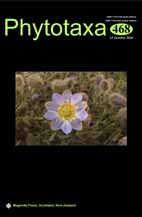Abstract
Gigartina skottsbergii is the currently accepted name for the large, peltate species of Gigartinaceae distributed in Argentina, Chile, and along the Antarctic Peninsula. However, phylogenetic analyses of DNA sequences for more than twenty years indicate that two species are passing under the name G. skottsbergii, and both DNA sequences and morpho-anatomy indicate that the species are assignable to an undescribed genus. To formally validate the new genus and species, we performed next generation sequencing (NGS) on the lectotype material of G. skottsbergii to document its genetic identity and obtained its complete mitogenome and partial plastid genome. Phylogenetic analysis of rbcL and cox1 sequences of the lectotype along with recent collections of G. skottsbergii from southern South America and Antarctica, confirmed the generic distinction and the presence of two morphologically similar taxa. We propose Sarcopeltis gen. nov., containing the generitype S. skottsbergii comb. nov. from southern South America, and S. antarctica sp. nov. from the Antarctic Peninsula. Sarcopeltis is characterized by the following suite of features: 1) peg-like secondary haptera that adhere to the substratum, 2) absence of an envelope surrounding each cystocarp, 3) presence of extensive, terminal, tubular gonimoblast filaments that fuse with surrounding vegetative cells, and 4) tetrasporangia formed from secondary filaments entirely in the medulla. This study demonstrates that genetic analysis of type material, together with recently obtained DNA sequences from field collected specimens, can provide clear and objective taxonomic conclusions.

